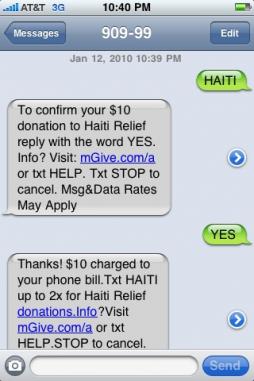We are releasing today the first-ever Nonprofit Text Messaging Benchmark Study (PDF) The study, sponsored by Mobile Commons and mGive, takes a look at how organizations in the United States are using text messaging and how subscribers are responding. It reveals that mobile phones are becoming increasingly popular for advocacy with organizations.
Written by Michael Amoruso and Jessica Bosanko of M+R Strategic Services and Katrin Verclas of MobileActive.org, the report “provides benchmarks and metrics by which nonprofit organizations can measure their success with text messaging and illustrate the various ways in which organizations are using text messages.”
The earthquakes in Haiti earlier this year showed that SMS can be a powerful tool for fundraising (raising millions in just a few days); it’s clear that the time is ripe for non-profits to tap into the mobile market in order to engage their supporters. According to the Mobile Benchmark study (PDF), there are currently over 276 million wireless users in the U.S. and during the first half of 2009, users sent about 740 billion text messages. The report breaks down not only how non-profits can use SMS to interact with supporters, but also releases statistics on how specific organizations fared with their SMS campaigns.
The study gathered its data from profiling six organizations (American Society for the Prevention of Cruelty to Animals (ASPCA), Planned Parenthood, NARAL Pro-Choice America, Humane Society of the United States, Defenders of Wildlife, and Human Rights Campaign ) that ran SMS campaigns from August 2008 to August 2009. The study targets list growth, list source, list churn (turnover), and message subjects. Highlights include:
- For the organizations that participated in this study, over 80 percent of subscribers were existing supporters recruited from their online program.
- Lists grew at a rate of 49.5 percent annually.
- The annual churn rate for text lists was 30.7 percent. The benchmark text message unsubscribe rate was 0.69 percent.
- The response rate for call-in advocacy text messages was 4.7 percent - nearly six times the 2009 benchmark response rate of 0.82 for call-in advocacy emails.
The report also looked into the type of messages that the non-profits were sending to their subscribers. The results fell into five categories: fundraising, advocacy, informational, go-to-web, and text reply. Non-profits in the U.S. are starting to be more involved in the mobile world, recognizing that mobile phones provide opportunities to directly engage supporters, while also bringing new members to their causes. PDF of the study is here.
Image courtesy of Flickr user curiouslee
| Mobile Benchmarks 2010: How Are Non-Profits Using Text Messaging? data sheet 7299 Views | |
|---|---|
| Countries: | United States |


I think texting to get
I think texting to get relief for Haiti was so successful because not only it's very easy to do (you don't need to pull out your credit card or call somewhere and stay on hold), but also because people were given easy and precise instructions. When you are asked "donate", you feel like you have to clear your bank account to do so. But when it's specified that it will only be $10, people think "I can do that". This way more people are likely to donate and if you add up all the $10s - it will come up to a pretty number.
Thanks for sharing
Anneryan, Great post, thank you for sharing. I always thought that the text to give to Haiti relief funds was a brilliant idea. Easy for everyone to do, actionable because its clear what they have to do to give.
Another piece of new tech that I am pretty excited about is Square, www.squareup.com. I could see this being a boon for nonprofits at events and fundraisers.
Looking forward to digging into the Benchmark Study later today.
Matt
Post new comment